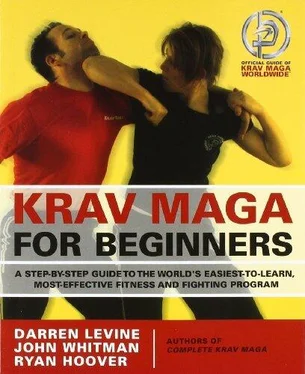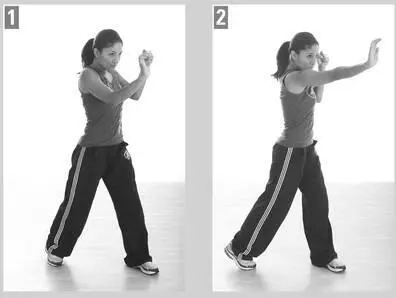
Training Tips:By moving your fingers out of the way, you force the heel of your hand, rather than your fingers, to make contact. If you don’t rotate, your wrist may be bent backward on impact, potentially causing a sprain or break.
Elbows are effective weapons at close range, and can be delivered at almost any angle with power. Keep in mind that there are more than seven elbow strikes. There are, in fact, a nearly infinite number of angles. However, we teach seven elbows as a way of communicating the general movements to beginners. As you train more, you will find variations on these angles based on your position and the position of your opponent.
The striking surface for the elbows is a small surface area just above or below the tip of your bent elbow. Try to strike with the smallest surface possible so that the force of your strike is concentrated. This creates maximum penetration and damage. Also, for all elbow strikes, bring your hand to your shoulder, creating a sharp bend in the elbow itself. Your hand can be closed in a fist or slightly curled at the fingers—whatever is most comfortable for you. Be aware that if you close your fist too tightly, you will tighten up the muscles of your arm and reduce your speed.
For training purposes, we show elbows only with the right hand, but of course the left elbow can be delivered from all the same angles. Also, for all of these elbows, you should begin with what we’ll call a “modified neutral stance.” That is, a neutral stance, but with your hands up. This facilitates the training. Later, you can step into a fighting stance and train from there as well.

The striking surface for both of these elbow strikes is just above the tip of the elbow.
Horizontal High Elbow Strike (Elbow #1)
This elbow strike targets an attacker coming from the front.
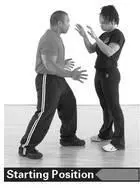
Starting Position:Modified neutral stance with both hands up.
1Bring your right hand in to your shoulder, creating a firm bend in your elbow.
2Sharply swing your elbow out horizontally in front of you to make contact with your target’s face or throat. Strike with the point just below the tip of your elbow, pivoting as you strike to generate more power.
Recoil and return to starting position.
Training Tips:Beginners are sometimes confused by the angle of this attack. This elbow can be delivered in a circular motion (traveling in front of your body from right to left) or in a forward motion (traveling outward like a straight punch), depending on the position of the target.
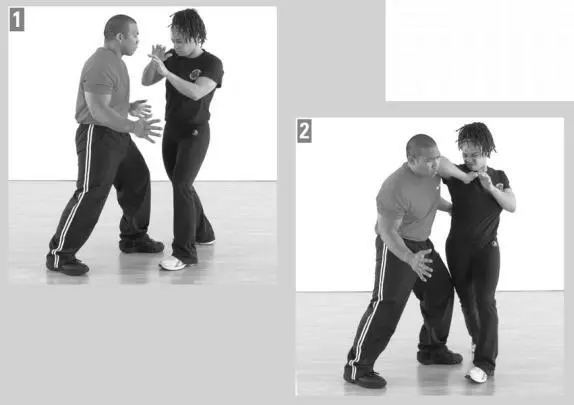
Sideways Elbow Strike (Elbow #2)
This elbow strike targets an attacker coming from the side.

Starting Position:Modified neutral stance with both hands up.
1Bring your right hand in to your shoulder, creating a firm bend in your elbow. Raise your elbow up.
2Strike to the side, avoiding a ʺflap ping” motion. Lean in as you strike, making contact just above the tip of your elbow. Use your legs for power.
Recoil and return to starting position.
Training Tips:The most common mistake beginners make is forgetting to add power by using their legs and body. Be careful not to simply “poke” with your elbow itself—drive through with your legs.

Horizontal Elbow Strike Backward (Elbow #3)
This elbow strike targets an attacker coming from behind.
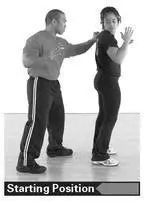
Starting Position:Modified neutral stance with both hands up.
1Bring your right hand in to your shoulder, creating a firm bend in your elbow.
2Pivot as you punch your elbow horizontally to a target behind you, looking back over your shoulder to see your target; make sure to keep your chin tucked for protection. Strike with the point just above the tip of your elbow.
Recoil and return to starting position.
Training Tips:This is a very powerful elbow that you will use often when learning bearhug defenses. Make it a comfortable part of your arsenal.

Vertical Elbow Strike Backward Low (Elbow #4)
This elbow strike targets an attacker coming from behind.
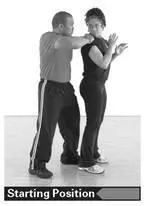
Starting Position:Modified neutral stance with both hands up.
1Send your elbow straight back to make contact with your target’s ribs or stomach. Strike with the point just above the tip of your elbow, pivoting as you strike to generate more power.
Recoil and return to starting position.
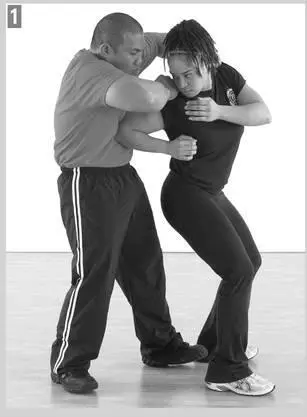
Training Tips:It’s good to practice this elbow by keeping your arm close to your body. Assume that someone is trying to grab you in a bearhug from behind. If you swing your arm away from your body as you strike backward, you may find your arm blocked. Think of your forearm brushing along your ribs.
Vertical Elbow Strike Backward (Elbow #5)
This elbow strike targets an attacker coming from behind.
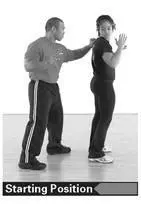
Starting Position:Modified neutral stance with both hands up.
1Bring your right hand in to your shoulder, creating a firm bend in your elbow.
2-3Punch your elbow backward and upward, tilting your shoulders forward to strike the attacker’s throat or face. Strike with the point just above the tip of your elbow.
Recoil and return to starting position.
Training Tips:This elbow is very similar to #4—just tilt forward slightly so that your elbow drives upward instead of straight back. In a real fight, the act of tilting forward also creates a little space between you and your attacker, giving your elbow room to drive upward forcefully.
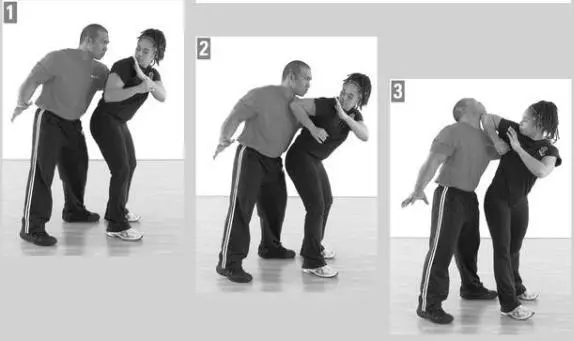
Vertical Elbow Strike Forward and Upward (Elbow #6)
Читать дальше
